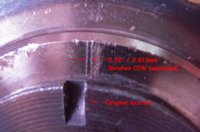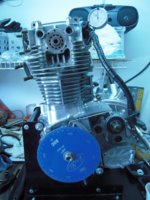Hi Barncat,
It is more than just finding TDC used to set proper timing. You need to, with a dial indicator find TDC for the camshaft and adjust it. It is best to find a percentage of opening and closing on the intake valve. You will then need to determine the degrees you are retarded, press the camshaft gear off the end of the cam and rotate to the new correct mark you have made and press it back on. We're talking a very small circumferential rotation to make it right. Your camshaft and crankshaft will then be at TDC. For race motors you would set it an an even more advanced position but not what we're after here.
Notes that I compiled with sources. The last part is for my engine
http://www.xs650.com/forum/showthread.php?t=12847
"For inspection valve lash, refer to the factory service manual at
www.biker.net . To find TDC, rotate to your piston stop CCW and read the degree wheel. Then slowly rotate CW and read the degree wheel. True TDC is the midpoint between these two readings. For example, if your first reading is 10* BTDC and your second reading is 20* ATDC, move your pointer to read 15* off TDC in both positions. TDC will now be at the 0 mark.
Degreeing in the cam to the lobe centers usually involves altering the spec valve events, due to grind error. Refer to
www.muzzys.com/articles/lobe_centers.html . Calculate lobe centers as installed, then play with the formula to determine where valve openings/closings need to occur to arrive at the spec lobe centers.
Ditto what Grizld1 said, repeatability is vital. In addition, make sure the degree wheel is perfectly centered on the shaft and secure.
It is difficult to get accurate opening and closing readings because it will vary based on valve lash and indicator accuracy. Setting the came based on lobe center is more repeatable (accurate). I checked the opening and closing events for my cam at 0.010" intervals from 0.010" - 0.070". The opening and closing events were all different (duh) but the lobe center calculations for all settings, except 0.010", were within a degree from each other. The readings at 0.010" were all over the map because of the "quiet ramps" on the cam. That is why the manual says to set the lash to 0.012" when checking valve timing, so the valve won't start moving until after the ramps. I prefer to use zero lash since it's easier and repeatable. With zero lash, ignore any readings under 0.020" lift.
I gave a brief explanation of lobe centers in the e-mail but I will expand on it here. The lobe center is the point where the valve is at max lift. Measuring this directly is difficult so we calculate it from the opening and closing events. Using your numbers above;
Add the opening and closing events together, 25 + 61 = 86
Add 180 to find the duration, 86 + 180 = 266
Divide duration by 2, 266 / 2 = 133
Subtract open/close even closest to TDC, 133 - 25 = 108
So your intake lobe center is 108 degrees. The spec for the 447 cam is 106 so you are 2 degrees retarded according to your first test.
in your second test you had;
36 + 70 = 106
106 + 180 = 286
286 / 2 = 143
143 - 36 = 107
107 is one degree retarded from spec and pretty darned close to what you got the first time despite the different setup and readings."
&&&&&&&&&&&&&&&&&&&&&&&&&&&&&&&
My (Glenn's) values, the 447 cam used in the XX650F2 are shown attached.
The values I determined are as follows:
So for the intake
36 + 180 + 68 = 284°
(284 / 2) – 36 = 106° = lobe center
This 106° is what I needed to get to which was 3.5° of CCW rotation on the cam.
The second picture is the angle change I needed for my cam. The last shows my degree wheel and dial indicator setup.



